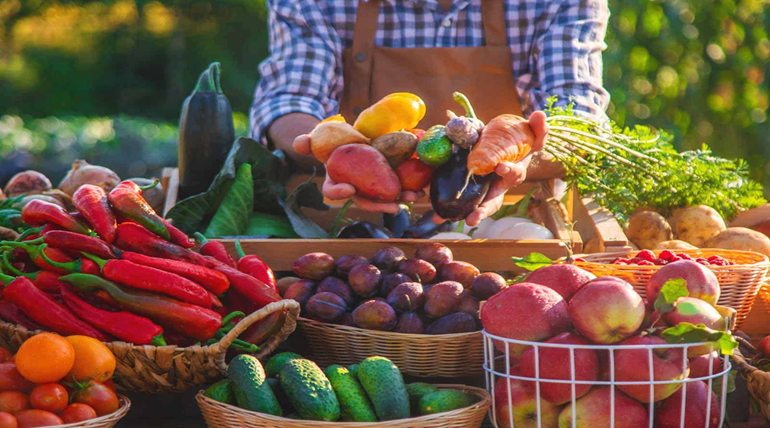Seasonal Eating: Why Eating Local, Seasonal Foods is Better for You

10 months ago
Seasonal Eating: Why Eating Local, Seasonal Foods is Better for You
In our modern world, it is easy to get any food at any time of year. Thanks to globalization and advanced agricultural practices, we have access to a wide variety of fruits and vegetables, no matter the season.
However, eating seasonally by choosing to enjoy foods that are in peak production during their natural season can have numerous benefits for your health, the environment, and your wallet.
Let us explore why seasonal eating is a practice worth embracing.
What is Seasonal Eating?
Seasonal eating refers to consuming foods that are harvested during their specific growing season in your local region. Different fruits and vegetables are harvested at different times of the year, depending on the climate and geography. For example, strawberries are in season in late spring and early summer, while root vegetables like carrots and potatoes peak in fall and winter.
Eating seasonally means enjoying the freshest, most flavorful foods that nature has to offer. When you choose seasonal produce, you not only support local farmers but also align with the rhythm of nature, taking advantage of the natural cycle of food growth.
The Health Benefits of Eating Seasonal Local Foods
- More Nutrients and Flavor: One of the biggest advantages of eating seasonal foods is that they are often fresher and more dense in nutrients than out of season produce. When fruits and vegetables are harvested at their peak ripeness, they contain more vitamins, minerals, and antioxidants. Seasonal produce is also more flavorful because it has had time to fully mature before being harvested. Compare an out-of-season tomato that has been shipped thousands of miles away with a locally grown tomato picked fresh from a local farm. You will notice the difference in taste immediately as seasonal produce tends to be juicier, sweeter, and more aromatic.
- Supports Your Immune System: Seasonal eating often means you are consuming foods that are naturally aligned with the time of year. For example, root vegetables and citrus fruits are available in the winter, providing a healthy dose of vitamin C and immune boosting nutrients to help your body fight off colds and flu. In the summer, you might enjoy lighter, hydrating fruits like watermelon and berries, which help you stay hydrated during the warmer months. Eating seasonal foods helps your body adjust to the changing seasons and boosts its ability to stay healthy in different weather conditions.
- Increased Antioxidant Levels: Seasonal foods are packed with antioxidants, which help to neutralize harmful free radicals in your body. Seasonal fruits and vegetables, like apples in the fall and leafy greens in the spring, are known for their high antioxidant content, which can protect against diseases and support long-term health.
- Better Digestive Health: Many seasonal foods are rich in fiber, which supports digestive health. For example, in the fall, you might find squash, pumpkins, and apples, all of which are rich in fiber and help keep things moving smoothly in your digestive system. Eating a wide variety of seasonal produce will provide your body with the necessary nutrients to maintain a healthy gut.
Environmental and Economic Benefits of Seasonal Eating
Supports Local Farmers and Reduces Carbon Footprint: When you eat locally grown, seasonal foods, you help support local farmers and contribute to the sustainability of the agricultural community. Locally grown produce doesn’t require long-distance transportation, reducing the environmental impact associated with shipping food across the country or even around the world. This can help cut down on carbon emissions, packaging waste, and overall environmental harm.
Additionally, seasonal food production generally uses fewer resources, such as artificial heating, pesticides, and fertilizers, since it aligns with the natural growing season. Supporting local farmers helps maintain healthier ecosystems and fosters community growth.
Lower Cost: Seasonal produce is often more affordable than out-of-season items because it’s more abundant. Since seasonal foods are grown locally and harvested in larger quantities, the supply is greater, and prices tend to be lower. On the other hand, off-season produce must be imported, which raises its price due to shipping and storage costs. By eating in-season, you can save money while enjoying fresh, high-quality food.
Reduces Food Waste: Because seasonal foods are grown locally and harvested in abundance, they often reach their peak freshness faster and last longer in your home. When you eat what is in season, there’s less chance of food spoilage because you’re purchasing produce at its freshest, which ultimately reduces waste.
How to Start Eating Seasonally
Keep a Seasonal Food Calendar: One of the simplest ways to start eating seasonally is to keep a calendar of when fruits and vegetables are in season in your area. This will give you a visual guide to what is available, and it can help you plan meals that align with the harvest.
Preserve Seasonal Foods If you love seasonal fruits and vegetables but want to enjoy them year-round, consider preserving them through methods like canning, freezing, or drying. You can store seasonal foods and enjoy their nutritional benefits long after the harvest season has ended.
Join a CSA (Community Supported Agriculture) Program: A CSA is a subscription-based service where you can receive a box of seasonal, local produce delivered to your door or available for pickup. It is an excellent way to explore new seasonal foods that you may not usually buy at the grocery store.
Conclusion
Seasonal eating is a simple, sustainable practice that not only benefits your health but also supports your local economy and the environment. By eating foods that are in season and locally grown, you are giving your body the nutrients it needs, reducing your carbon footprint, and enjoying the best that each season has to offer.
Start small by incorporating more seasonal foods into your meals, and watch as you reap the health benefits and enjoy fresher, more flavorful food.
©everlastcyber





0 Comment